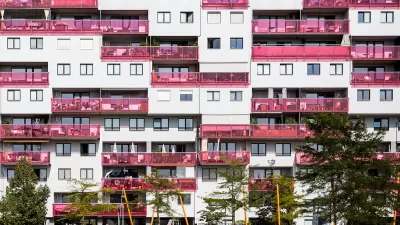The tax on property sales above $5 million has brought in less revenue last year than experts projected, but the measure could still become a significant contributor to affordable housing funds.

A so-called ‘mansion tax’ in Los Angeles that taxes land transactions over $5 million to raise funds for affordable housing and other housing programs has brought in less revenue than expected, reports Sarah Holder in Bloomberg CityLab.
According to Holder, Measure ULA has brought in just $142 million, short of the $900 million in annual projected revenue. “As the housing market stabilizes, the real estate industry adapts, and various lawsuits move through the appeals process, advocates say the tax will prove its worth. By November, monthly sales over $5 million had nearly tripled since cratering in April, bringing in nearly $14 million for Measure ULA.”
Holder notes that “Although single-family homes represent the largest share of its projected revenue at 38%, the tax also applies to most multifamily developments, office buildings and hotels.” Some developers say this will hamstring the construction of multifamily apartment buildings, including affordable housing. “A 2022 UCLA study somewhat assuaged concerns about affordable housing, suggesting that the tax would have little impact on multifamily construction, in part because developers rarely sell their properties right after building them.”
Despite the backlash, “Already, 19 affordable housing projects with a total of 1,500 units have applied for a piece of the $56.8 million in Measure ULA funding available. Short-term rental assistance has started going out to tenants and landlords.” And other cities are proposing their own mansion taxes, including Santa Fe, Chicago, and Seattle.
FULL STORY: As ‘Mansion Taxes’ Catch On in US Cities, Los Angeles Offers Lessons

Planetizen Federal Action Tracker
A weekly monitor of how Trump’s orders and actions are impacting planners and planning in America.

San Francisco's School District Spent $105M To Build Affordable Housing for Teachers — And That's Just the Beginning
SFUSD joins a growing list of school districts using their land holdings to address housing affordability challenges faced by their own employees.

The Tiny, Adorable $7,000 Car Turning Japan Onto EVs
The single seat Mibot charges from a regular plug as quickly as an iPad, and is about half the price of an average EV.

With Protected Lanes, 460% More People Commute by Bike
For those needing more ammo, more data proving what we already knew is here.

In More Metros Than You’d Think, Suburbs are Now More Expensive Than the City
If you're moving to the burbs to save on square footage, data shows you should think again.

The States Losing Rural Delivery Rooms at an Alarming Pace
In some states, as few as 9% of rural hospitals still deliver babies. As a result, rising pre-term births, no adequate pre-term care and "harrowing" close calls are a growing reality.
Urban Design for Planners 1: Software Tools
This six-course series explores essential urban design concepts using open source software and equips planners with the tools they need to participate fully in the urban design process.
Planning for Universal Design
Learn the tools for implementing Universal Design in planning regulations.
Smith Gee Studio
City of Charlotte
City of Camden Redevelopment Agency
City of Astoria
Transportation Research & Education Center (TREC) at Portland State University
US High Speed Rail Association
City of Camden Redevelopment Agency
Municipality of Princeton (NJ)





























